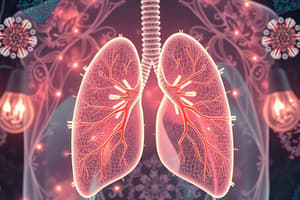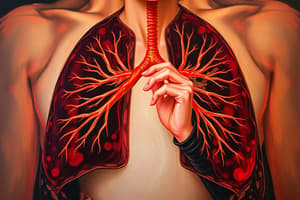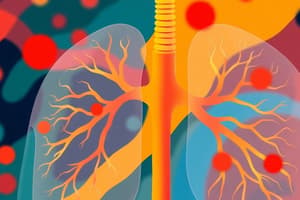Podcast
Questions and Answers
Which of the following medications acts by blocking the release of histamine and leukotrienes?
Which of the following medications acts by blocking the release of histamine and leukotrienes?
- Albuterol
- Ipratropium
- Cromolyn Sodium (correct)
- Beclomethasone
What is the primary mechanism of action for inhaled corticosteroids in treating asthma?
What is the primary mechanism of action for inhaled corticosteroids in treating asthma?
- Direct bronchodilation
- Stimulation of surfactant production
- Suppression of airway inflammation (correct)
- Increase in mucociliary clearance
Which type of inhaled drug delivery device is most likely to be affected by patient technique and inspiratory flow rate?
Which type of inhaled drug delivery device is most likely to be affected by patient technique and inspiratory flow rate?
- Metered Dose Inhaler (MDI)
- Dry Powder Inhaler (DPI) (correct)
- Soft Mist Inhaler (SMI)
- Nebulizer
What is the primary reason for using a spacer with a Metered Dose Inhaler (MDI)?
What is the primary reason for using a spacer with a Metered Dose Inhaler (MDI)?
Which of the following is NOT a common characteristic of therapeutic aerosols?
Which of the following is NOT a common characteristic of therapeutic aerosols?
Which of the following factors is MOST likely to influence the deposition of aerosol particles in the lower respiratory tract?
Which of the following factors is MOST likely to influence the deposition of aerosol particles in the lower respiratory tract?
Which of the following mechanisms describes the deposition of aerosol particles in the upper airways due to their momentum?
Which of the following mechanisms describes the deposition of aerosol particles in the upper airways due to their momentum?
What is the term used to describe the tendency of aerosol particles to settle out under the influence of gravity?
What is the term used to describe the tendency of aerosol particles to settle out under the influence of gravity?
Which type of inhaler device is typically used for administering nebulized medications?
Which type of inhaler device is typically used for administering nebulized medications?
What is the recommended mass median aerodynamic diameter (MMAD) of aerosol particles for deposition in the lower airways?
What is the recommended mass median aerodynamic diameter (MMAD) of aerosol particles for deposition in the lower airways?
Which of the following is a potential hazard associated with aerosol therapy?
Which of the following is a potential hazard associated with aerosol therapy?
Which of the following medications is a leukotriene antagonist?
Which of the following medications is a leukotriene antagonist?
Which of the following respiratory diseases is characterized by inflammation and narrowing of the airways, leading to wheezing, coughing, and shortness of breath?
Which of the following respiratory diseases is characterized by inflammation and narrowing of the airways, leading to wheezing, coughing, and shortness of breath?
Which of the following is NOT an advantage of aerosol therapy for respiratory diseases?
Which of the following is NOT an advantage of aerosol therapy for respiratory diseases?
Which of the following medications is classified as a short-acting beta-agonist (SABA) and used as a bronchodilator in asthma and COPD?
Which of the following medications is classified as a short-acting beta-agonist (SABA) and used as a bronchodilator in asthma and COPD?
Which of the following is NOT a phase of drug action?
Which of the following is NOT a phase of drug action?
What is the main purpose of the pharmacokinetic phase of drug action?
What is the main purpose of the pharmacokinetic phase of drug action?
Which of the following is a method of topical application of drugs?
Which of the following is a method of topical application of drugs?
What is the primary route of administration for drugs intended for the respiratory system?
What is the primary route of administration for drugs intended for the respiratory system?
Which of the following is NOT a factor that influences the amount of drug reaching the site of action?
Which of the following is NOT a factor that influences the amount of drug reaching the site of action?
What is the name for the drug that binds to the receptor and triggers a biological response?
What is the name for the drug that binds to the receptor and triggers a biological response?
Which of the following is a phase in the process of drug investigation and approval?
Which of the following is a phase in the process of drug investigation and approval?
What is the primary function of the pharmacokinetic phase in drug action?
What is the primary function of the pharmacokinetic phase in drug action?
Flashcards
Pharmacokinetic phase
Pharmacokinetic phase
The phase of drug action involving absorption, distribution, metabolism, and excretion.
Pharmacodynamic phase
Pharmacodynamic phase
The phase where drug effects occur at the site of action, influencing physiological responses.
Drug sources
Drug sources
Origin of drugs, including natural, synthetic, and biopharmaceutical sources.
Drug names
Drug names
Signup and view all the flashcards
Parenteral route
Parenteral route
Signup and view all the flashcards
Topical application methods
Topical application methods
Signup and view all the flashcards
Inhalation
Inhalation
Signup and view all the flashcards
Process of drug approval
Process of drug approval
Signup and view all the flashcards
Protein binding
Protein binding
Signup and view all the flashcards
Pharmacodynamics
Pharmacodynamics
Signup and view all the flashcards
Drug-receptor interactions
Drug-receptor interactions
Signup and view all the flashcards
Drug interactions
Drug interactions
Signup and view all the flashcards
Therapeutic index
Therapeutic index
Signup and view all the flashcards
Pulmonary infections
Pulmonary infections
Signup and view all the flashcards
Obstructive lung diseases
Obstructive lung diseases
Signup and view all the flashcards
Interstitial lung disease
Interstitial lung disease
Signup and view all the flashcards
Pleural diseases
Pleural diseases
Signup and view all the flashcards
Acute respiratory disease syndrome
Acute respiratory disease syndrome
Signup and view all the flashcards
Bronchodilators
Bronchodilators
Signup and view all the flashcards
Mucolytic agents
Mucolytic agents
Signup and view all the flashcards
Corticosteroids
Corticosteroids
Signup and view all the flashcards
Aerosol therapy
Aerosol therapy
Signup and view all the flashcards
Hazards of aerosol therapy
Hazards of aerosol therapy
Signup and view all the flashcards
Study Notes
Pulmonary Pharmacology
- Pharmacology is the study of how drugs interact with organisms, altering their functions or processes.
- Drugs are chemicals that affect biological processes.
- Drugs can be sourced from plants (e.g., khellin, atropine, digitalis), minerals, and chemically synthesized compounds.
- Drugs are administered in different phases.
- The drug administration phase involves dosage forms and routes of administration.
- The pharmacokinetic phase describes drug absorption, distribution, metabolism, and excretion.
- The pharmacodynamic phase is the interaction of the drug and its target cells or receptors.
- Drug investigation involves animal studies and phases 1, 2, and 3 clinical studies before FDA approval.
Drug Names
- Chemical names describe a drug's chemical structure (e.g., acetylsalicylic acid for aspirin).
- Code names are assigned by manufacturers during drug development.
- Generic names are the official, non-proprietary names (e.g., ASA).
- Trade names are the brand names (e.g., Aspirin).
Drug Sources
- Chemical synthesis is the most common drug source.
- Plant extracts (e.g., thyroid hormone, insulin, pancreatic dornase) are other sources.
Drug Administration
- Drug administration phases involve factors like bioavailability, absorption rate, and stability.
- Routes of administration include oral (tablet, capsule, pill), intravenous, intramuscular, subcutaneous, and others.
Drug Interactions
- Additivity describes when the total effect of two drugs equals the sum of the individual effects.
- Synergism means two drugs create a larger effect than expected.
- Potentiation occurs when one inactive drug increases the effect of another.
- Antagonism is a situation where two drugs counteract each other.
Drug Receptor Interactions
- Drug affinity measures the drug's tendency to bind to a receptor.
- Drug efficacy measures the drug-receptor complex's effect.
- Agonists both have affinity and efficacy, simulating receptor action.
- Antagonists have affinity but no efficacy, blocking receptor action.
Factors Controlling Drug Amounts
- Absorption involves drug movement from the site of administration to the bloodstream.
- Distribution is the transport of the drug throughout the body.
- Metabolism is the breakdown of the drug in the body, often in the liver, to inactive forms.
- Elimination is the removal of the drug (and its metabolites) from the body, most often through the kidneys.
Respiratory Diseases and Specific Drugs
- Respiratory diseases are diverse, including pneumonia, tuberculosis, asthma, COPD, and others.
- Various drug types are used to treat these conditions, such as bronchodilators, mucolytics, and steroids.
Studying That Suits You
Use AI to generate personalized quizzes and flashcards to suit your learning preferences.




